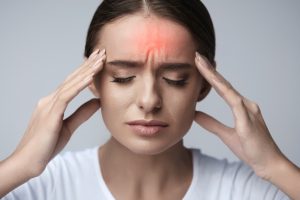Is the pressure or pain in your head a headache or a migraine? Knowing the difference between the two can help offer faster relief through treatment.
What is a headache?
Headaches cause unpleasant pain or pressure and aching feeling. Headache pain can range from mild discomfort to severe and there are many different types, the most common including:
- Tension: Feels like a constant aching or pressure on both sides of the head or at the back of the head and neck. Usually triggered by stress, muscle strain and anxiety.
- Cluster: Severely painful on one side of the head and comes in cycles.
- Sinus: Occur with symptoms of sinus infection including fever, stuffy nose, cough, congestion and facial pressure.
Headaches can occur in the forehead, temples and back of the neck and can last anywhere from 30 minutes to a week!
What is a migraine?
Anyone who has experienced a migraine can attest to how painful they are! Migraine’s are a type of headache which is intense or severe and usually accompanied by other symptoms, including:
- Nausea
- Vomiting
- Sensitivity to light
- Pain behind one eye or ear
- Temporary vision loss
- Seeing spots or flashing lights
Other differences between a headache and migraine include:
- Migraines are typically characterised by an intense throbbing pain which interferes with your ability to complete everyday tasks.
- Typically, they only affect one side of the head.
- Migraines can occur with aura: A sensation that may be experienced 10 – 30 minutes before an attack. This includes seeing flashing lights, tingly or numbness of face or hands, unusual smell, taste or touch and difficulty concentrating.
- A day or two before a migraine some also experience: depression, constipation, frequent yawning, sensitivity to light or sound, vomiting, vision loss, seeing spots or flashing light.
Treating a headache or migraine
Though tension-type headaches and migraines share similarities they can often be treated differently. Common headaches are generally treated with over the counter drugs: aspirin, ibuprofen or paracetamol. Other treatment options include:
- Caffeine
- Hydrating
- Relaxation techniques
- Acupuncture or massage to relieve pressure
If you suffer from chronic migraines identifying common triggers and avoiding them may help reduce occurrences. Common triggers include:
- Skipping meals
- Caffeine withdrawal
- Some alcoholic beverages
- Dehydration
- Bright or flickering lights
- Strong smells
- Loud sounds
- Oral contraceptives
- Pregnancy
- Menopause
- Lack of sleep
- Illness
- Back and neck pain
As each individual may have a different trigger, treatments can include lifestyle modification, medication and/or complimentary therapy. Acute treatment options include:
- Over the counter medication: Aspirin, ibuprofen, paracetamol
- Prescribed non-steroidal anti-inflammatory drugs
- Stronger narcotic-type analgesics
- Prescribed medication to minimise nausea, such as Maxolon.
If you suffer from frequent migraines preventative treatments and complementary therapies may be required. This can include daily medication, acupuncture, osteopathy and more.





